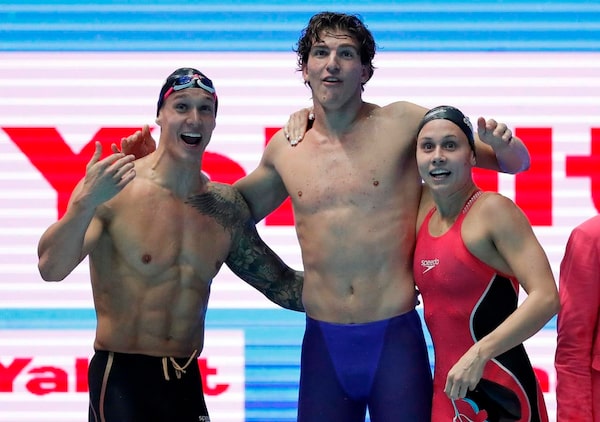Team Ontario's Megan Sibthorpe, left, and Katie Vincent celebrate their gold medal win in the women's C2 500m at the Canada Games in Sherbrooke, Que., Aug. 12, 2013.Paul Chiasson/The Canadian Press
In Tokyo this summer, Canadian paddler Katie Vincent will be among the first women to compete for an Olympic canoe medal, something men have been doing at the Games since 1936.
The IOC says Tokyo will be the most gender-balanced Olympics in history. Adding three women’s canoe events to the program for the first time is just one piece in a larger scheme to level the gap in Olympic participation between male and female athletes.
More than a century after women first competed at an Olympics, the number of female competitors will almost match the number of male competitors in Tokyo. Nearly 49 per cent of the Olympians will be women, according to the IOC quotas – a record, and up from 45.6 per cent at Rio in 2016 and the 38.2 per cent at Sydney in 2000. The IOC has set a goal for Paris in 2024: to have the same number of men and women competitors.
At the Tokyo Paralympics at least 40.5 per cent of all the athletes will be women, up from 38.6 per cent in Rio.
Changes to the Olympic program are always intriguing but this summer there are some significant moves toward gender equity. Tokyo’s five new sports – baseball/softball, karate, skateboarding, speed climbing and surfing – will all have women’s events. There is also a long list of sports that will make alterations – big or subtle – to improve their gender balance. Some will reduce the number of male athletes or events in order to make more room for women. There will be new mixed team events, in which genders compete together. And for the first time, all participating countries should have at least one female and one male on their team.
Previously, women competed only in kayaks at the Olympics, while men raced in canoes and kayaks. In Tokyo, both genders will have the same number of races in both boats.
“It definitely brought our sport from one of the most unequal to completely equal,” said Vincent, a world champion sprint paddler from Mississauga, who will be in the debut of the women’s C1 200-metre event, and also hopes to earn a spot with a teammate in the C2 500-metre event.
“It’s in our hands now to do something good with it. To come home with a women’s medal would be a very powerful moment for our sport in Canada.”
Gender equity has been an initiative of the IOC for 25 years, as it worked with countries and international sport federations to increase the opportunities for women. The numbers were climbing slowly until it became a priority in the IOC’s Agenda 2020 strategic roadmap, set in 2014 after Thomas Bach became president, and the recently updated as Agenda 2020+5.
“The leadership has made all the difference. They sent a very strong message and the sports, they heard it – it was almost like ‘change or be changed,’ ” said Canadian Olympic Committee president Tricia Smith, who is also VP of the International Rowing Federation. “The sports were headed in that direction anyways, but it was taking such a long time.”
Smith competed in three Olympics, the first in 1976 when female rowers entered the Games – 76 years after men made their Olympic rowing debut.
“Back then, I wasn’t looking around thinking about, ‘well how many other women are there here with me?’ ” Smith said. “But when I look back at the pictures of the Canadian team coming into the opening ceremony in 1976, I see it now – only 20 per cent were women.”
Efforts at gender equity at this summer’s Games were upstaged recently by two instances of derogatory remarks from men within the leadership of the Tokyo Olympics.
Hiroshi Sasaki, creative director of Tokyo’s opening and closing ceremonies, resigned after saying Japanese female comedian and plus-sized fashion designer Naomi Watanabe could play the role of an “Olympig.” Tokyo organizing committee president Yoshiro Mori stepped down amid backlash over his complaint that women talk too much during board meetings. Mori was replaced by a woman – Seiko Hashimoto, a seven time Japanese Olympian in cycling and speed skating.
In Tokyo, four sports – canoe/kayak, rowing, shooting, weightlifting – will have an equal number of events for men and women for the first time. All of those, plus sailing and judo, will have gender balance.
Adding spots for women has led to reducing spots for men, to keep numbers from getting unwieldy. The Olympics are already enormous – more than 11,000 athletes are expected in Tokyo.
Weightlifting, for instance, will have 196 competitors in Tokyo (compared with 260 in Rio), and one male weight class has been cut. Men and women will both have seven weight divisions, with 14 athletes in each.
Canadian weightlifter Maude Charron hopes to make her first Olympic appearance. She has seen considerable efforts globally to advance women’s weightlifting, addressing challenges such as the lack of female coaches and the complicated psychology of body image in their sport.

Maude Charron of Canada celebrates winning the Women's 63kg Weightlifting Final on day three of the Gold Coast 2018 Commonwealth Games at Carrara Sports and Leisure Centre on April 7, 2018 on the Gold Coast, Australia.Mark Metcalfe/Getty Images
“They’re trying very hard to make this equal for women in weightlifting – they have now a women’s commission, the athlete’s rep is a woman from Britain,” Charron said. “On paper it looks good, it’s 50-50, that’s great, but on the political side, there’s still a lot of work to do.”
Olympic Boxing will take a step toward improved gender balance in Tokyo. Women’s boxing made its debut in 2012 with just three weight classes compared with 10 for men. This summer, there will be eight divisions for men and five for women.
Boxing Canada’s high-performance director, Daniel Trepanier, said women will have a better chance to fight at their desired weight, rather than trying to fit into one of the three previous Olympic weight classes. He says the skill level in women’s boxing has grown since 2012, but knows more spots in the Olympics means high expectations on the sport globally.

Caroline Veyre of Canada, in blue, and Kellie Anne Harrington of Ireland, in red, compete during their 60kg category quarter-final fight at the 2018 AIBA Women's World Boxing Championships in New Delhi on Nov. 20, 2018.MONEY SHARMA/AFP/Getty Images
“Every continent is going to have to keep developing the quality of its boxers, because you don’t want to dilute your product because you’re getting more quota,” Trepanier said. “But we’ve seen big evolution on the women’s side.”
Cycling is working toward gender equality at the 2024 Games, when 514 athletes will compete across disciplines, equally divided among men and women. In Tokyo the genders will compete in equal numbers in mountain bike, BMX racing and two new events, BMX freestyle park and madison.
“Women’s professional road cycling doesn’t get anywhere near the same sort of mainstream media coverage that men’s does, so the Olympics have a disproportionate importance for women’s cycling,” said Kris Westwood, Cycling Canada’s high-performance director. “It will be really good to see them on an equal footing with the men in Paris.”
The number of mixed-gender events across sports will increase to 18 – double the number that were included in 2016. It’s an opportunity to showcase men and women competing together.
Three new mixed-relay events will make their Olympics, featuring teams of two men and two women competing together. Triathlon’s mixed relay will see four teammates each complete in a 300-metre swim, 6.6-kilometre bike and one-kilometre run. Athletics will introduce a co-ed 4x400-metre, and in swimming a 4x100-metre medley.

United States mixed 4x100m freestyle relay team members, from left, Caeleb Dressel, Zach Apple and Mallory Comerford celebrate after winning the gold medal at the World Swimming Championships in Gwangju, South Korea, July 27, 2019.The Associated Press
“I would love to be on Canada’s mixed relay for sure,” said Canadian swimmer Brent Hayden, a bronze medalist in the 100-metre freestyle at the 2012 Olympics. He hopes to make a comeback in Tokyo after seven years away from the sport.
In shooting, three men’s events are subtracted in Tokyo and three mixed events added – for rifle, pistol and trap. Canada won’t compete in the co-ed shooting events, because Lynda Kiejko is the lone Canadian shooter to qualify for Tokyo, and she will compete in the women’s 10-metre air pistol and 25-metre pistol. She has shot in mixed events at other competitions though, and enjoys them.
Her father – the late Bill Hare – was a three-time Olympian who competed in 1964, 1968 and 1972. While she’s excited to see her sport adding mixed events at the Olympics, she was also sentimental about seeing some of the popular men’s events disappear.
“It’s a bit conflicting for me personally because I had to see my dad’s favourite events disappear,” Kiejko said. “But as far as competing in a mixed team event, it’s really fun.”
 Rachel Brady
Rachel Brady